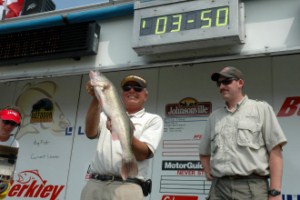Walleye First Tournament Series Part 3, Walleye Tournament Future
Category: article
Jun 5th, 2012 by OutdoorsFIRST
Modified Jun 5th, 2012 at 12:00 AM
Author’s Note: Over the next several months, a series of columns will explore the status of the walleye tournament world with a vision for the future. Many industry leaders, observers, participants (past and present), sponsors, professional and amateur anglers, host communities, marine and tackle manufacturers, and tournament organizers will offer their opinions.
Part Three is the perspective of a 3-time PWT winner (Champion at Lake of the Woods, the first-ever PWT tournament winner and Saginaw Bay), and an early proponent of forming an angler’s professional organization, Steve Fellegy.
Steve wakes up every morning, looks out his window at the big lake, and decides if this is another day he should head out onto Mille Lacs. The answer is usually “Yes,” where he trolls lead core and cranks about 75 percent of the time.
 |
|
|
|
Steve said, “We need to change the model or we may run out of anglers. Will there be 50 percent fewer fishermen in 20 years? Unless we create interest and a larger fan base and get more kids on the water, I’m afraid that could be the case. Then, where will the people come from that buy boats, rods, tackle and fish tournaments?”
From his perspective, the tournament fishing game has not followed the model of major league baseball, the NFL, NASCAR or golf. “The news about those sports deals mostly with the human interest side of the players and maybe 25 percent with the intricate details. The average football fan may not know what a chop-block is, because they don’t need to know to be a fan. But, in the walleye world, everybody knows boats, outboards, jigs, graphite rods and Lowrance electronics.”
Avid anglers know and care about Ron Seelhoff’s trolling methods and Daryl Christensen’s jigging spoons, but Steve said, “The story should be about people – the players themselves.” When visiting an ad agency to discuss competitive walleye angling, Steve said the ad guys liked the events and the outdoors, but asked, “What about the people?”
Fellegy listed some story lines that would build and keep consumer interest 12 months of the year. He said, “There could be stories about wars on the water, personalities, issues, money and personal (family) struggles, accomplishments, injuries, cover it all.” He recalled the ad agency telling him the big leagues do human interest stories five days a week to get people to the ball games on weekends.
A typical story from pro football is about age or injury forcing a great player to retire. “In the walleye world, pros quit because they can’t afford it,” he said. That’s the reason for AIM hitting the water with 50 boats and the FLW running around 100 boats. “The expenses to tour are out of sight or more guys would be doing it,” he said. “The business model needs to be adjusted so the cost to compete isn’t an issue.”
One idea offered was that a tiny percentage of industry sales be set aside in a general sponsorship account and paid to pro anglers who compete. These elite pros would become industry spokesmen tasked to attract the next wave of anglers.
He also felt privately owned teams of anglers would compete not only for individual honors, but for team glory. “If Berkley had a team, there could be trades, free-agency, drafts, strategy, and news all year round,” he said. “For instance, if a tournament circuit included several rivers, the team might need more river experts, and trade or draft accordingly.” He also noted that a team filled with western reservoir experts would make news when they were forced to deal with Great Lakes tournaments.
Steve also suggested that the pro fishing world should involve more transparency. The recently concluded NFL draft was all about the money college graduates would receive. He said, “Why not let the world know about the deals pro anglers get. That could be the benchmark for others. Many people believe pros are getting paid big bucks when in fact they’re buying equipment at discounts and not getting paid.”
Another area where he saw industry advantages would be better training of pros. “The main reason most pros don’t live up to what sponsors expect is because they receive very little or no pay from those sponsors,” he said. “Fishermen have always been promoters, but the average guy is not a marketing genius. We all need help in this area.”
Steve admitted he did not have all the answers, but in addition to his observations, applauded the direction that AIM is going. “This is the direction things should go,” he said. However, he said if AIM can’t hire someone to chase and secure sponsorships from outside the tackle and marine industries, the future could be bleak. He also said, “If the focus is on people, the potential for success is significant.”
After discussing this subject, Steve said, “The National Professional Anglers Association is in a position to make a difference. They are organized to attract youth, promote tournaments, enhance professionalism, and assure the future is bright. One of my prouder moments was when I instigated the Walleye Players Association, the forerunner of NPAA.” He sat back and reflected, “My how the years have slipped away.”